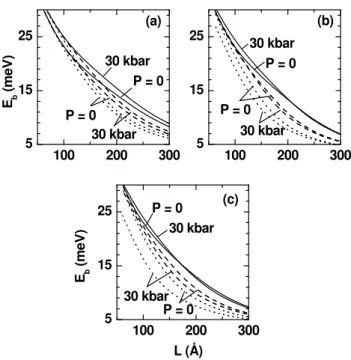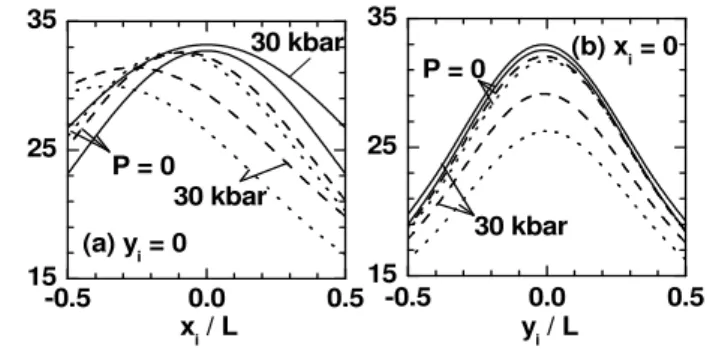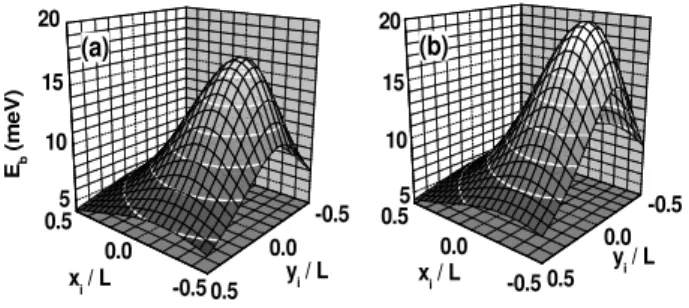944 Brazilian Journal of Physics, vol. 36, no. 3B, September, 2006
Hydrostatic Pressure and Electric-field Effects on the Shallow Donor Impurity States in
GaAs-Ga
0.7Al
0.3As Quantum-well Wires
J. W. Gonz´alez1, N. Porras-Montenegro2, and C. A. Duque1
1Instituto de F´ısica, Universidad de Antioquia, AA 1226, Medell´ın - Colombia 2Departamento de F´ısica, Universidad del Valle, AA 25360, Cali - Colombia
Received on 8 December, 2005
Using a variational procedure within the effective-mass approximation, we have made a theoretical study of the effects of hydrostatic pressure and applied electric fields on the binding energy of a shallow-donor impurity in square-transversal section GaAs-Ga0.7Al0.3As quantum-well wires. The electric field is applied in a plane of the transversal section of the wire and many angular directions are considered. The hydrostatic pressure has been considered both in the direct and indirect gap regime for theGa0.7Al0.3Asmaterial. For the potential barrier that defines the wire region, we consider anx-dependent finite andy-dependent infinite model. The results we present are for the impurity binding energy and considering different values of the wire dimensions, hydrostatic pressure, applied electric field, and the impurity position in the transversal section of the wire.
Keywords: Quantum well wire; Hydrostatic pressure; Electric field
I. INTRODUCTION
With the development of experimental techniques and an-alytical methods, there has been a considerable amount of work devoted to the study of the states of hydrogenic impuri-ties in low-dimensional semiconductor heterostructures such as quantum wells (QWs), quantum-well wires (QWWs) and quantum dots (QDs)[1–6]. The effects of external perturba-tion such as magnetic fields, hydrostatic pressure or electric fields on the physical properties of low-dimensional systems constitute a subject of considerable interest from both theoret-ical and technologtheoret-ical points of view, due to the importance of these systems in the development of new semiconductor devices and applications.
Some studies have been reported on the applied electric-field dependence of the shallow donor- and/or acceptor-impurity binding energies of the ground and first few excited states in QW and QWW heterostructures with a fixed direc-tion of the external field [3–5]. They have reported the shal-low donor and/or acceptor density of impurity states, donor-related optical absorption and acceptor-donor-related photolumines-cence spectra.
The aim of the present work is to study the hydrosta-tic pressure and Stark effects on confined donor impuri-ties in square-shaped transversal-section GaAs-Ga0.7Al0.3As
QWWs including the angular dependence of the field along the transversal section of the wire. Calculations are performed using a variational procedure within the effective-mass ap-proximation. Image effects are not considered and the dielec-tric constant and effective masses are taken as the GaAs values along all regions of the heterostructure.
II. THEORETICAL FRAMEWORK
Using the effective-mass approximation, the Hamiltonian for a donor impurity confined in a square-transversal-section GaAs-Ga0.7Al0.3As QWW under hydrostatic pressure (P),
and transversal applied electric field (~F) is given by
H=− ~
2
2m∗(P)∇
2+e|~F|[xcos(θ) +ysin(θ)]
+V(P,x,y)− e 2
ε(P)r , (1) whereris the carrier-impurity distance andε(P)is the static dielectric constant [5].m∗(P)is electron effective-mass [5],θ is the electric field relative angle to thex-axis andV(P,x,y) is the potential barrier that confines the carrier in the wire region considered as zero within the wire region,V0(P)for |x| ≥Lx(P)/2 [6], and infinite for|y| ≥Ly(P)/2, whereLx(P)
andLy(P)are the pressure dependent transversal dimensions
of the wire [5, 7].
For the donor wave function we use a variational procedure and assume a hydrogenic-type trial wave function as [3]
Ψ(r) =NΦ(x,y)e−λr, (2) whereN is a normalization constant, λ is a variational pa-rameter, andΦ(x,y) = f(x)g(y) is the eigenfunction of the Hamiltonian in Eq. (1) without the impurity potential, where [3, 5]
f(x) =
ek1x, x≤L
x(P)/2,
αAi(x) +βBi(x), |x| ≤Lx(P)/2,
e−k2x, x≥L
x(P)/2,
(3)
and
g(y) =
½
δAi(y) +σBi(y), |y| ≤Ly(P)/2,
0, y≥Ly(P)/2. (4)
Here Ai and Bi are the usual Airy functions. The
donor-impurity binding energy is calculated from the definition
Eb=E0−Emin(λ), (5)
whereEminis the eigenvalue for the Hamiltonian in (1),
mini-mized with respect to the variational parameter, andE0is the
J. W. Gonz´alez et al. 945
III. RESULTS AND DISCUSSION
-0.5 0.0 0.5
5 10 15
(a) F = 100 kV/cm
P = 0
Lx = 100 Å, Ly = 1000 Å Lx = 1000 Å, Ly = 100 Å
Eb
(
m
eV
)
xi / L; yi / L
0 10 20 30
5 8 11 (b)
Lx = 200 Å, Ly = 1000 Å 20 kV/cm
40 kV/cm
60 kV/cm
100 kV/cm F = 0
P (kbar)
FIG. 1: Binding energy of a donor-impurity in GaAs QWs obtained by consider limiting cases of the transversal-section of the QWWs. In (a) the results are as a function of the impurity position along the growth direction of the QW heterostructure, whereas in (b) the results are for on-center impurity and as a function of hydrostatic pressure. In all cases, the electric field is applied in the growth direction of the QW.
In Fig. 1, we present our results for the binding energy of a donor-impurity in rectangular transversal section QWWs. If Lxis large enough (1000 ˚A in this case) keepingLy=100 ˚A
as a constant value, we reproduce the results for the vacuum-GaAs-vacuum QW [3], and ifLyis large enough (1000 ˚A in
this case) keepingLx=100 ˚A or 200 ˚A as a constant value,
we reproduce the results for the GaAs-Ga0.7Al0.3As QW [3,
5]. In what follows, we will limit our discussion to square-transversal section QWWs, i.e, to the case in whichLx(P) =
Ly(P) =L(P).
In Fig. 2, we present our results for the binding energy, for an on-axis shallow-donor impurity in a squared-transversal section GaAs-Ga0.7Al0.3As QWW, as a function of the side
(L(P)) of the wire. As a general feature, we observe that the binding energy increases as the transversal-cross section of the wire decreases. As an effect of the applied electric field, the electron wave function shifts towards the opposite direction of the field, giving origin to a polarization of the system and, con-sequently, an increase in the expectation value of the electron-impurity distance. Therefore, the electron-impurity binding energy decreases as the Coulomb interaction gets weaker. As one applies hydrostatic pressure, there are direct modifications of three critical parameters, i.e., the dielectric constant, the elec-tron effective-mass and the wire section. Associated with the decrease of the dielectric constant with pressure, an increase in the binding energy is observed. Additionally, due to the dif-ference of pressure coefficients between the well and barrier materials, we observe a slight increase in the binding energy. When the dimensions of the wire are of the order of the GaAs effective Bohr radius, we observe the largest electric-field de-pendence forθ=π/4 [Fig. 2(b)] andθ=0 [Fig. 2(c)]. Also, the smallest electric-field dependence occurs when the elec-tric field is applied along the direction of the infinite-potential barriers (θ=π/2) [Fig. 2(a)], in which case the rigid barriers repel the electron wave function towards inside the wire
re-100 200 300
5 15 25
100 200 300
5 15 25
100 200 300
5 15 25
30 kbar P = 0
(b)
30 kbar P = 0
Eb
(
m
eV
)
L (Å) (a)
Eb
(
m
eV
) 30 kbar
P = 0
30 kbar P = 0
P = 0 30 kbar
P = 0 30 kbar
(c)
FIG. 2: Binding energy as a function of the side in squared-transversal section GaAs-Ga0.7Al0.3As QWW, for two different val-ues of the hydrostatic pressure. Results are for three directions of the applied electric field:θ=π/2 (a),θ=π/4 (b) andθ=0 (c) and for three different values of the applied electric field: 50 kV/cm (solid lines), 100 kV/cm (dashed lines), and 200 kV/cm (dotted lines).
gion. For a low-value of the width of the transversal section (L<a∗), we observe that the structure is in the high-confining geometrical regime and a small dependence with the electric field is observed.
Figure 3 displays the calculated results for the binding en-ergy as a function of the(xi,yi=0)transversal impurity
po-sition in GaAs-Ga0.7Al0.3As QWWs. We find that for
cen-946 Brazilian Journal of Physics, vol. 36, no. 3B, September, 2006
ter of the section of the wire because the impurity is displaced perpendicularly to the direction of the applied electric field.
-0.5 0.0 0.5
5 10 15 20
-0.5 0.0 0.5
5 10 15
20 (b) 200 kV/cm
P = 0
30 kbar
xi / L (a) 10 kV/cm
E b
(
m
eV
)
xi / L 30 kbar
P = 0
FIG. 3: Binding energy as function of the(xi,yi=0) transversal impurity position in GaAs-Ga0.7Al0.3As QWWs. Results are for
L= 200 ˚A and for two different values of the hydrostatic pressure. Electric field values are 10 kV/cm (a), and 200 kV/cm (b) and the electric field direction is given by θ=π/2 (solid lines), θ=π/4 (dashed lines), andθ=0 (dotted lines).
In Fig. 4 we present the binding energy as a function of the(xi=0,yi)shallow-donor impurity positions in a
GaAs-Ga0.7Al0.3As QWW. We find, as in Fig. 3, the same
asym-metries in the binding-energy curves for small values of the applied electric field [Fig. 4(a)]. However, due to the infinite-potential barriers, significative changes in the binding energies are only observed when the impurity is near the wire-axis. The effect of the high applied electric field [Fig. 4(b)] is to com-pletely break up the symmetry of the binding-energy curves, except when the field is inθ=0 direction; in this case the electric field is only applied inxdirection, and the effect is very similar to the zero electric field case. Also, forθ=π/4 andθ=π/2, we have that the binding energy converges to essentially the same value, for different pressures, when the impurity is near toyi= +0.5L. This effect is associated with
the high polarization of the confined system.
-0.5 0.0 0.5
5 10 15 20
-0.5 0.0 0.5
5 10 15 20
yi / L (a) 10 kV/cm
Eb
(
m
eV
)
yi / L 30 kbar
P = 0
(b) 200 kV/cm
P = 0
30 kbar
FIG. 4: Results are as in Fig. 3, but for(xi=0,yi)impurity positions.
In Fig. 5, we present the shallow-donor impurity binding energy as a function of the transversal impurity position in anL=50 ˚A GaAs-Ga0.7Al0.3As QWW and for an applied
electric field of 200 kV/cm . In Fig. 5(a) solid lines are sym-metrical because the electric field is applied perpendicular to the direction in which the impurity moves. The binding en-ergy for the 30 kbar case is larger than for the zero pressure
one, and for all impurity positions, mainly due to the dimin-ishing in the value of the static dielectric constant. When the electric field has components along thexdirection the sym-metry of the binding energy curves, with respect to the center of the section of the wire, is breaking [3]. Now, the pres-sure effects show for example that when the impurity is lo-cated close tox=−0.5Lthe binding energy forP=30 kbar is larger that forP=0 whereas for impurity positions close tox= +0.5Lthe contrary effect occurs. In the last case, as effect of the pressure, two components of the problem should be considered: 1. the finite potential barrier diminishes al-lowing that the electron-wave function be more symmetrical with respect to the impurity center; 2. the static dielectric constant diminishes giving an increment in the Coulomb in-teraction. The two combined effects carry to the increasing in the binding energy. For the impurity close tox=−0.5Lthe situation is as follow: 1. due to the small value of the wire di-mensions (L=50 ˚A) in spite of the applied electric field, the electron-wave function is confined in the wire region as ef-fect of the potential barrier. 2. When the pressure increases, the finite barrier inx=−0.5L diminishes allowing that the electron-wave function penetrates in thex<−0.5L. For Fig. 5(b) the situation is as follow. Dotted lines correspond to the case in which the impurity moves perpendicularly to the field and for it the curves are symmetrical. Solid and dashed lines correspond to the case in which the electric field has compo-nents in the same direction in which the impurity moves. The high symmetry in the curves for these two last cases is due to the fact that the infinite potential barriers do not allow that electron-wave function goes out of the region of the wire as effect of the applied electric field or as effect of the shifting of the impurity. The pressure effect (30 kbar) on the dotted and/or dashed lines is due to the diminishing in the finite po-tential barrier which allows that the expectation value of the electron-impurity distance increases carrying to a diminishing in the Coulomb interaction. For solid lines we observe very small effects with the pressure because the infinite potential barrier hides the electric field effects.
-0.5 0.0 0.5
15 25 35
-0.5 0.0 0.5
15 25 35
(b) xi = 0
yi / L
30 kbar P = 0
(a) yi = 0
30 kbar
xi / L
P = 0 30 kbar
FIG. 5: Binding energy as a function of the shallow-donor impurity position. Results are for(xi=0,yi)impurity positions (a) and for (xi,yi=0)impurity positions (b). Here, we consider the case of anL=50 ˚A GaAs-Ga0.7Al0.3As QWW and an applied electric field
F=200 kV/cm. Curves for two values of the hydrostatic pressure are shown. Results are presented for the same directions as in Fig. 3.
J. W. Gonz´alez et al. 947
binding energy as a function of the(xi,yi)impurity position in
square-transversal section GaAs-Ga0.7Al0.3As QWWs. This
set of figures shows us the combined effects of the hydrostatic pressure and electric field applied along the diagonal direction of the transversal section of the wire. The results show that the maximum of the binding energy is located outside of the axis of the QWW and locatednearthe diagonal that corresponds to the direction of the applied electric field. The word near in the last sentence means that in spite of the squared section of the wire the maximum of the binding energy is not located along the diagonal of the wire due to the asymmetry associ-ated with the two kinds of potential barriers, both inxandy directions.
0.5 0.0
-0.5 5
10 15 20
0.5 0.0
-0.5 0.5
0.0 -0.5 5
10 15 20
0.5 0.0
-0.5 Eb
(
m
e
V
)
(b)
yi / L
xi / L
(a)
yi / L
xi / L
FIG. 6: Binding energy as a function of the(xi,yi)impurity position in aL= 200 ˚A GaAs-Ga0.7Al0.3As QWW. Results are forF =50 kV/cm, with aθ=π/4 direction and two different hydrostatic pres-sures,P=0 (a) andP= 30 kbar (b).
IV. CONCLUSIONS
Using a variational procedure within the effective-mass ap-proximation, we have calculated the combined effects of an applied electric field and hydrostatic pressure on the bind-ing energies of a shallow-donor impurity in square-transversal
section GaAs-Ga0.7Al0.3As QWWs. We have observed
im-portant changes in the binding energy with the applied electric field fundamentally in the regime of wires with large traverse sections and mainly when the applied electric field have an important component along thex-axis (direction of the finite confinement potential barrier). This last effect is due to the possibility that the electron-impurity system is polarized. In the regime of wires with small cross sections, the effects of the electric field are very minute because the wave function is quite concentrated in the region of the barrier. It is pos-sible, however, to observe important dependencies with the direction of the field. Moreover, we have observed that the shallow donor impurity binding energy increases and/or de-creases with the increasing in the external hydrostatic pres-sure. This ambiguity is associated with the combination of many factors such as: the impurity position, the dimensions of the transversal section of the wire, the intensity of the ap-plied electric field, and finally with the direction of the apap-plied electric field. In the absence of the electric field, the binding energy is degenerate for symmetrical positions of the impu-rities with respect to the center of the transversal section of the wire. However, this degeneracy is broken when an elec-tric field is applied and there are changes along its direction. Some results show that in spite of the applied electric field the binding energy curves can be degenerated for some special impurity positions in the transversal section of the wire.
V. ACKNOWLEDGEMENTS
We are grateful to Luiz E. Oliveira for a critical reading of the manuscript, and would like to thank the Colombian COL-CIENCIAS Agency and CODI-Universidad de Antioquia for partial financial support. This work has been partially sup-ported by the Excellence Center for Novel Materials ECNM, under Colciencias contract No. 043-2005.
[1] Heon Ham and Harold N. Spector, Phys. Rev. B 62, 13599 (2000).
[2] Hong-Jing Xie, Physica E22, 906 (2004).
[3] R. B. Santiago, L. E. Oliveira, and J. d’Albuquerque e Castro, Phys. Rev. B46, 4041 (1992).
[4] A. Latg´e, N. Porras-Montenegro, and L. E. Oliveira, Phys. Rev. B51, 2259 (1995).
[5] A. L. Morales, A. Montes, S. Y. L´opez, and C. A. Duque, J. Phys: Condens. Matter14, 987 (2002).
[6] A. M. Elabsy, J. Phys.: Condens. Matter6, 10025 (1994), and references therein.


